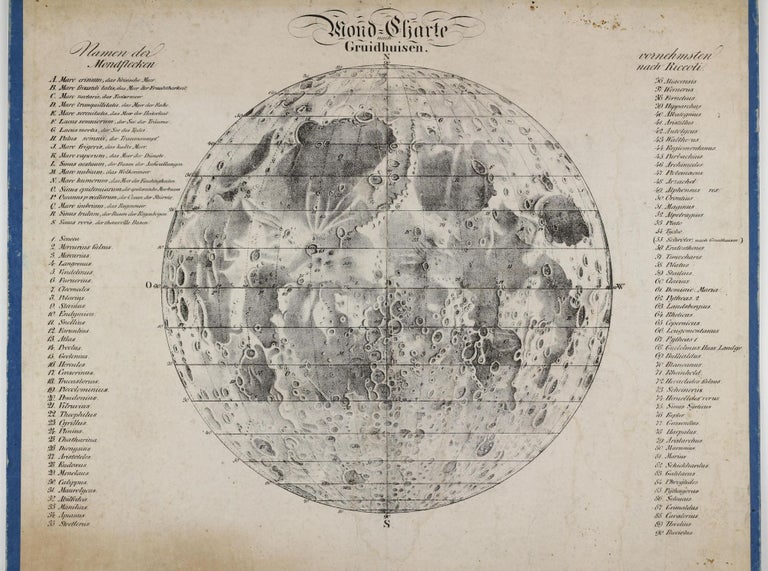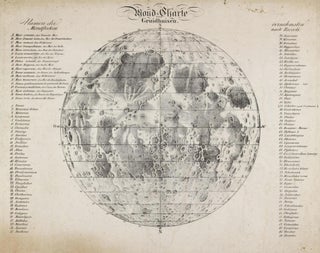Mond-Charte nach Gruithuisen.
1825.
1st Edition. No Binding. Very Good. Item #002188
No place, no date (but ca. 1825). Lithographed map of the full moon on a single unfolded sheet, pasted onto cardboard, total size 410 x 495 mm. Very minor, mostly marginal, browning and soiling. ----
EXCEPTIONALLY RARE separate map of the moon by or after Gruithausen in orthographic projection, like Johann Tobias Mayer's map with lunar coordinates. In addition there are the mare and prominent features named after Riccioli. This map is probably the first in which mare names are translated to any other language (here German). Gruithuisen published his map first in 'Selenognostische Fragmente', 1821, then in Gedenkschriften der Bonner Akademie der Naturforscher, 1822 and in Berliner Astronomisches Jahrbuch, 1822. The present map appears to have been redrawn from Gruithuisen's original at some later date, with the nomenclature possibly copied (with some spelling errors) from, Johann Schröter's version of Mayer's map, except that at #55 the name Schröter ("after Gruithuisen" -- a reference to his "city") is inserted and the remaining numbers are increased by one (see the-Moon Wiki Map Collection, showing this map).
Baron Franz von Paula Gruithuisen (March 19, 1774 - 1852) was a Bavarian physician and astronomer. He taught medical students before becoming a professor of astronomy at the University of Munich in 1826. Like others before and since his time, Gruithuisen believed that the Earth's moon was inhabitable. He made multiple observations of the lunar surface that supported his beliefs, including his announcement of the discovery of a city in the rough terrain to the north of Schröter crater he named the Wallwerk. This region contains a series of somewhat linear ridges that have a fishbone-like pattern, and, with the small refracting telescope he was using, could be perceived as resembling buildings complete with streets. He published his observations in 1824, but they were greeted with much scepticism by other astronomers of the time. His claims were readily refuted using more powerful instruments. He is also noted for the discovery of bright caps on the cusps of the crescent Venus, and for being the first to suggest that craters on the Moon were caused by meteorite impacts. He proposed that jungles on Venus grew more rapidly than in Brazil due to the proximity of the planet to the Sun, and that as a consequence the inhabitants celebrated fire festivals - the cause of the bright caps on Venus. The Gruithuisen crater on the Moon is named for him.
Price: 3,500 € * convert currency
Delivery time up to 10 days. For calculation of the latest delivery date, follow the link: Delivery times
Lieferzeit max. 10 Tage. Zur Berechnung des spätesten Liefertermins siehe hier: Lieferzeiten



